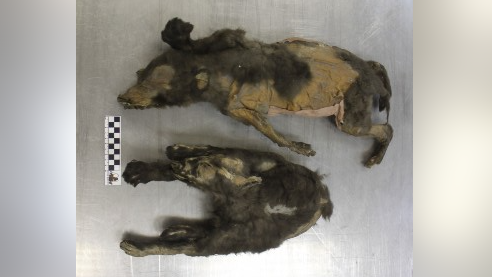14,000-year-old ice age 'puppies' were actually wolf sisters that dined on woolly rhino for last meal
A pair of canines found in Siberian permafrost were wolf sisters that died shortly after eating.

A pair of 14,000-year-old "puppies" found melting out of the permafrost in Siberia have undergone genetic testing, proving they were actually wolf cub sisters and not domesticated dogs as was previously assumed.
"Whilst many will be disappointed that these animals are almost certainly wolves and not early domesticated dogs, they have helped us get closer to understanding the environment at the time, how these animals lived, and how remarkably similar wolves from more than 14,000 years ago are to modern day wolves," Anne Kathrine Runge, an archaeologist at the University of York in the U.K., said in a statement.
Runge led an international team of researchers in analyzing the bones and DNA of the puppies. Their study, published Thursday (June 12) in the journal Quaternary Research, revealed that the mummified "puppies" were wolf littermates that died somewhere between 14,100 and 15,000 years ago.
The remarkably preserved and mummified animal carcasses were found in 2011 and 2015 near the rural settlement of Tumat in far northern Siberia. Along with the two canines, scientists discovered woolly mammoth (Mammuthus primigenius) bones that appeared to have been cut and burned by humans. This archaeological evidence suggested that the canines could have been very early domesticated dogs that were seeking food from humans — such as a piece of woolly rhino meat that was discovered in the belly of one of the animals.
Dogs and wolves are closely related, but they diverged genetically between 20,000 and 40,000 years ago. Humans then domesticated wild dogs around 15,000 years ago. But the title of the world's oldest domesticated dog has never been clearly claimed. One possibility is the Bonn-Oberkassel dog, found in Germany in a human burial dated to 14,200 years ago.
Because they were older than this, the ice age Tumat canines were previously assumed to be among the oldest domesticated dogs in the world. But DNA testing in 2019 showed that they likely belonged to a now-extinct wolf population unrelated to today's dogs.
Related: Frozen in time: 10 prehistoric animals found trapped in ice
Get the world’s most fascinating discoveries delivered straight to your inbox.
In the new study, Runge and colleagues built on the 2019 study by analyzing genetic data from the animals' gut contents and investigated chemical "fingerprints" in their bones, teeth and tissue to learn more about the famous cubs.
The cubs — genetically determined to be sisters — were only a couple of months old when they died, but both were eating solid food, including meat from a woolly rhino (Coelodonta antiquitatis) and a small bird called a wagtail — but not from a mammoth, which may have indicated that ice age humans had fed them leftover scraps. Additionally, both were still being nursed by their mother, the researchers discovered.
"It was incredible to find two sisters from this era so well preserved, but even more incredible that we can now tell so much of their story, down to the last meal they ate," Runge said in the statement.
But there's no indication that the Tumat pups got this food directly from humans or even from scavenging humans' mammoth butchering sites, according to the researchers. The sisters "inhabited a diverse landscape that was also occupied by humans," they wrote, but "this study found no evidence that can conclusively link them to human activities."
How the cubs died remains a mystery, as well. Given the cubs' lack of injuries, they may have been resting in an underground den when it collapsed, trapping them inside, the researchers wrote in the study.
"Today, litters are often larger than two, and it is possible that the Tumat Puppies had siblings that escaped their fate," study co-author Nathan Wales, an ancient-DNA specialist at the University of York, said in the statement. "There may also be more cubs hidden in the permafrost."
Additional research on the Tumat cubs may yet produce more information about ancient wolves and their evolutionary line, Wales noted in the statement.
Last ice age quiz: How much do you know about Earth's frosty past?

Kristina Killgrove is a staff writer at Live Science with a focus on archaeology and paleoanthropology news. Her articles have also appeared in venues such as Forbes, Smithsonian, and Mental Floss. Kristina holds a Ph.D. in biological anthropology and an M.A. in classical archaeology from the University of North Carolina, as well as a B.A. in Latin from the University of Virginia, and she was formerly a university professor and researcher. She has received awards from the Society for American Archaeology and the American Anthropological Association for her science writing.
You must confirm your public display name before commenting
Please logout and then login again, you will then be prompted to enter your display name.


